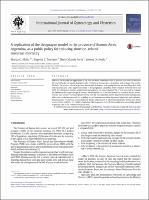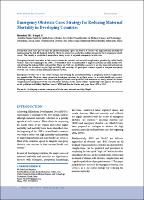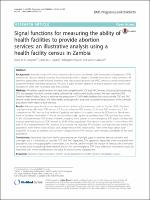A replication of the Uruguayan model in the province of Buenos Aires, Argentina, as a public policy for reducing abortion-related maternal mortality
Fecha
2016Autor
Matía, Marisa
Trumper, Eugenia
Orlando Fures, Nery
Orchuela, Jimena
Metadatos
Mostrar el registro completo del ítemResumen
OBJECTIVE: To describe the application of the risk and harm reduction model at primary care level to decrease the mortality due to unsafe abortion in the Province of Buenos Aires, Argentina, and evaluate the results.
METHODS: The services offered at primary health units to women undergoing abortion are described-first, only risk reduction and later, legal termination of the pregnancy-including their evolution between 2010 and 2015. The changes in abortion-related maternal mortality are also evaluated. The χ(2) test was used to evaluate the differences in the percentage of abortion-related deaths out of the total number of maternal deaths.
RESULTS: Primary care services increased progressively, both for risk reduction and for legal termination of pregnancy, which was carried out successfully, including manual vacuum aspiration, by general physicians and midwives. The proportion of abortion-related maternal deaths with respect to total maternal deaths fell by two-thirds between 2010 and 2014 (P<0.001).
CONCLUSION: The Uruguayan risk reduction model was successfully applied in primary care in the Province of Buenos Aires.
Colecciones
- Artículos [158]
- Artículos académicos [299]
- 2. América Latina y el Caribe [894]
- Argentina [338]
- Aborto autogestionado [32]
Ítems relacionados
Mostrando ítems relacionados por Título, autor o materia.
-
Emergency Obstetric Care: Strategy for Reducing Maternal Mortality in Developing Countries
Bhandari, TR; Dangal, G (2014)Twenty-five years have passed since the global community agreed in Nairobi to address the high maternal mortality by implementing the Safe Motherhood Initiative. However, every year nearly three million women die due to ... -
Signal functions for measuring the ability of health facilities to provide abortion services: an illustrative analysis using a health facility census in Zambia
Campbell, Oona; Aquino, Estela; Vwalika, Bellington; Gabrysch, Sabine (BMC Pregnancy and childbirth, 2016)Background Annually, around 44 million abortions are induced worldwide. Safe termination of pregnancy (TOP) services can reduce maternal mortality, but induced abortion is illegal or severely restricted in many countries. ... -
Comparing the quality of three models of postabortion care in public hospitals in Mexico City
Billings, Deborah; Fuentes Velásquez, Jaime; Pérez-Cuevas, Ricardo (IPAS, 2003)CONTEXT: Each year, an estimated 120,000 women in Mexico seek treatment in public hospitals for abortion-related complications--the country's fourth leading cause of maternal mortality. Models of postabortion care emphasizing ...



